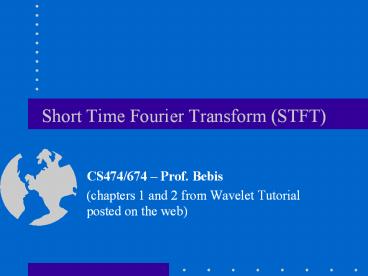Short Time Fourier Transform (STFT) - PowerPoint PPT Presentation
Title:
Short Time Fourier Transform (STFT)
Description:
Short Time Fourier Transform (STFT) CS474/674 Prof. Bebis Example (cont d) scaled: t/20 Example (cont d) scaled: t/20 Multiresolution Analysis The issue of ... – PowerPoint PPT presentation
Number of Views:1865
Avg rating:3.0/5.0
Title: Short Time Fourier Transform (STFT)
1
Short Time Fourier Transform (STFT)
- CS474/674 Prof. Bebis
- (chapters 1 and 2 from Wavelet Tutorial posted on
the web)
2
Fourier Transform
- Fourier Transform reveals which frequency
components are present in a given function.
(inverse DFT)
where
(forward DFT)
3
Examples
4
Examples (contd)
F1(u)
F2(u)
F3(u)
5
Fourier Analysis Examples (contd)
F4(u) ?
6
Limitations of Fourier Transform
- 1. Cannot not provide simultaneous time and
frequency localization.
Great localization in freq domain!
Poor localization in freq domain!
7
Limitations of Fourier Transform (contd)
- 2. Not very useful for analyzing time-variant,
non-stationary signals.
Non-stationary signal (varying frequency)
Stationary signal (non-varying frequency)
8
Limitations of Fourier Transform (contd)
Three frequency components, present at all times!
Three frequency components, NOT present at all
times!
F5(u)
F4(u)
Perfect knowledge of what frequencies exist, but
no information about where these frequencies
are located in time!
9
Limitations of Fourier Transform (contd)
- 3. Not efficient for representing non-smooth
functions.
10
Representing discontinuities or sharp corners
(contd)
FT
11
Representing discontinuities or sharp corners
(contd)
Original
Reconstructed
1
12
Representing discontinuities or sharp corners
(contd)
Original
Reconstructed
7
13
Representing discontinuities or sharp corners
(contd)
Original
Reconstructed
23
14
Representing discontinuities or sharp corners
(contd)
Original
Reconstructed
39
15
Representing discontinuities or sharp corners
(contd)
Original
Reconstructed
63
16
Representing discontinuities or sharp corners
(contd)
Original
Reconstructed
95
17
Representing discontinuities or sharp corners
(contd)
Original
Reconstructed
127
A large number of Fourier components is needed to
represent discontinuities.
18
Short Time Fourier Transform (STFT)
- Segment signal into narrow time intervals (i.e.,
narrow enough to be considered stationary) and
take the FT of each segment. - Each FT provides the spectral information of a
separate time-slice of the signal, providing
simultaneous time and frequency information.
19
STFT - Steps
- (1) Choose a window of finite length
- (2) Place the window on top of the signal at
t0 - (3) Truncate the signal using this window
- (4) Compute the FT of the truncated signal,
save results. - (5) Incrementally slide the window to the right
- (6) Go to step 3, until window reaches the end
of the signal
20
STFT - Definition
time parameter
frequency parameter
2D function
windowing function
centered at tt
21
Example
f(t)
0 300 ms ? 75 Hz sinusoid 300 600 ms ? 50
Hz sinusoid 600 800 ms ? 25 Hz sinusoid
800 1000 ms ?10 Hz sinusoid
22
Example
f(t)
0 300 ms ? 75 Hz 300 600 ms ? 50 Hz 600
800 ms ? 25 Hz 800 1000 ms ?10 Hz
W(t)
scaled t/20
23
Choosing Window W(t)
- What shape should it have?
- Rectangular, Gaussian, Elliptic
- How wide should it be?
- Should be narrow enough to ensure that the
portion of the signal falling within the window
is stationary. - Very narrow windows, however, do not offer good
localization in the frequency domain.
24
STFT Window Size
- W(t) infinitely long ? STFT
turns into FT, providing excellent frequency
localization, but no time localization. - W(t) infinitely short ?
results in the time signal (with a phase factor),
providing excellent time localization but no
frequency localization.
25
STFT Window Size (contd)
- Wide window ? good frequency resolution, poor
time resolution. - Narrow window ? good time resolution, poor
frequency resolution.
26
Example
different size windows
0 300 ms ? 75 Hz 300 600 ms ? 50 Hz 600
800 ms ? 25 Hz 800 1000 ms ?10 Hz
27
Example (contd)
scaled t/20
28
Example (contd)
scaled t/20
29
Heisenberg (or Uncertainty) Principle
Time resolution How well two spikes in time can
be separated from each other in the frequency
domain.
Frequency resolution How well two spectral
components can be separated from each other in
the time domain
30
Heisenberg (or Uncertainty) Principle
- We cannot know the exact time-frequency
representation of a signal. - We can only know what interval of frequencies
are present in which time intervals.































